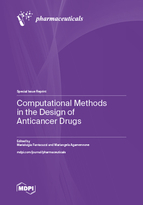Computational Methods in the Design of Anticancer Drugs
A special issue of Pharmaceuticals (ISSN 1424-8247). This special issue belongs to the section "Medicinal Chemistry".
Deadline for manuscript submissions: closed (31 January 2024) | Viewed by 32165
Special Issue Editors
Interests: drug discovery; computational techniques; anticancer agents; aromatase inhibitors
Special Issues, Collections and Topics in MDPI journals
Interests: drug design; in silico drug design; docking; pharmacophore; chemoinformatics; virtual screening; molecular dynamics; computer-aided drug design; MMP inhibitors; anticancer agents; anti-influenza agents; protein–protein interaction inhibitors; cancer immunotherapy
Special Issue Information
Dear Colleagues,
Cancer is still a major threat to human health and one of the leading causes of death worldwide. In recent years, advances in the development of new anticancer drugs have been continuous, and several compounds (small molecules, engineered antibodies, immunomodulators, etc.) have been approved for the treatment of cancer.
In recent decades, computational methods have become an essential tool in the drug design process as they are able to reduce research costs and accelerate the development process. The application of computational methods in the design of anticancer drugs has proved to be very effective. Given the wide variety of very different tumor forms and the multiplicity of possible pharmacological targets, this research area is very fruitful.
This Special Issue on "Computational methods in the design of anticancer drugs" aims to collect the most recent discoveries in the field of anticancer drug design with the aid of computational methods, such as structure-based drug discovery and ligand-based drug discovery classical or de novo drug design (molecular docking, virtual screening, pharmacophore mapping, similarity searching, QSAR modeling), molecular dynamics and the development of machine learning methods. These are some types of computational approaches that we would like to highlight in this Special Issue.
We are looking forward to your contribution.
Dr. Marialuigia Fantacuzzi
Dr. Mariangela Agamennone
Guest Editors
Manuscript Submission Information
Manuscripts should be submitted online at www.mdpi.com by registering and logging in to this website. Once you are registered, click here to go to the submission form. Manuscripts can be submitted until the deadline. All submissions that pass pre-check are peer-reviewed. Accepted papers will be published continuously in the journal (as soon as accepted) and will be listed together on the special issue website. Research articles, review articles as well as short communications are invited. For planned papers, a title and short abstract (about 100 words) can be sent to the Editorial Office for announcement on this website.
Submitted manuscripts should not have been published previously, nor be under consideration for publication elsewhere (except conference proceedings papers). All manuscripts are thoroughly refereed through a single-blind peer-review process. A guide for authors and other relevant information for submission of manuscripts is available on the Instructions for Authors page. Pharmaceuticals is an international peer-reviewed open access monthly journal published by MDPI.
Please visit the Instructions for Authors page before submitting a manuscript. The Article Processing Charge (APC) for publication in this open access journal is 2900 CHF (Swiss Francs). Submitted papers should be well formatted and use good English. Authors may use MDPI's English editing service prior to publication or during author revisions.
Keywords
- cancer drug design
- computational methods
- computer-aided drug design
- molecular docking
- molecular dynamics
- QSAR, machine learning
- chemoinformatics
- virtual screening
- pharmacophore models
- bioinformatics
- artificial intelligence
- DFT
- ab initio








